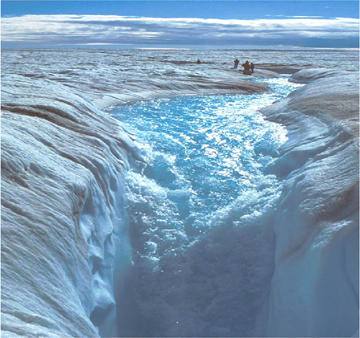
A glacial-melt stream on the top of the Greenland ice sheet in late summer. The stream is falling into a moulin where it travels to the base of the ice sheet.
Presenter: Compton Tucker
Goddard Fellow
Goddard Space Flight Center, NASA
The Earth's climate is determined by irradiance from the Sun and by properties of the atmosphere, oceans, and land that determine the reflection, absorption, and emission of energy within our atmosphere and at the Earth's surface. Since the 1970s, Earth-viewing satellites have complemented non-satellite geophysical information and led to an unprecedented understanding of the Earth's coupled ocean-land-atmosphere system. I will describe the Earth's climate system, as understood from data from earth-viewing satellites and ground-based geophysical monitoring stations, review arguments against global warming, and show the unprecedented convergence of evidence for global warming in the past few years. I will also discuss recent concerns about warming-induced instabilities to the ice sheets of Greenland and Antarctica.
Anyone outside NIST wishing to attend must be sponsored by a NIST employee and receive a visitor badge. For more information, call Kum J. Ham at 301-975-4203.
Colloquia are videotaped and available in the NIST Research Library.

